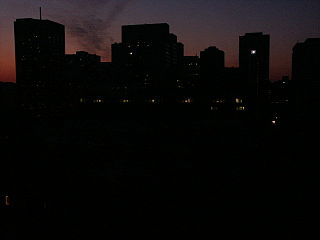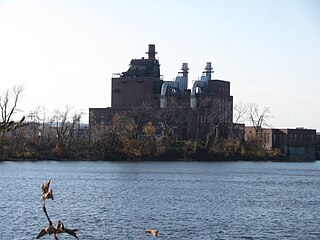
Athens is a town in Greene County, New York, United States. The population was 3,916 at the 2020 census. The town of Athens has a village also called Athens. The town is near the eastern edge of the county.
The New York City blackout of 1977 was an electricity blackout that affected most of New York City on July 13–14, 1977. The only unaffected neighborhoods in the city were in southern Queens, which were part of the Long Island Lighting Company system, as well as the Pratt Institute campus in Brooklyn, and a few other large apartment and commercial complexes that operated their own power generators.

The Kintigh Generating Station, also known as Somerset Operating Co. LLC of the Upstate New York Power Producers was a 675-megawatt coal-fired power plant located in Somerset, New York, United States. The plant was owned by AES Corporation until bankruptcy. Its unit was launched into service in 1984. Coal is provided to the plant via the Somerset Railroad. The waste heat is dumped into Lake Ontario, resulting in a warm-water plume visible on satellite images. The plant's 625-foot smoke stack can be seen across Lake Ontario from the shores of Toronto, Pickering, Oshawa, and Ajax, Ontario. It can also be seen from points along the Niagara Escarpment, including Lockport, NY, approximately 20 miles south. Power from the plant is transferred by dual 345kV power lines on wood pylons, which run south from the plant through rural agricultural land. In Royalton, NY they split at their physical junction with the dual circuit 345-kV Niagara-to-Edic transmission line, owned by the New York Power Authority, one circuit heads west to a substation at Niagara Falls, the other heads east to Station 80 south of Rochester. This bulk electric transmission constraint, created by the Somerset plant tie-in and forcing wheeling through 230kV and 345kV transmission lines to the Homer City Coal Plant east of Pittsburgh, PA, and returning to NY at the Watercurry substation outside Elmira, will be resolved through the Empire State Line proposal approved by NY Independent System Operator (NYISO).

Consolidated Edison, Inc., commonly known as Con Edison or ConEd, is one of the largest investor-owned energy companies in the United States, with approximately $12 billion in annual revenues as of 2017, and over $62 billion in assets. The company provides a wide range of energy-related products and services to its customers through its subsidiaries:

Southern California Edison (SCE), the largest subsidiary of Edison International, is the primary electric utility company for much of Southern California. It provides 15 million people with electricity across a service territory of approximately 50,000 square miles.

Indian Point Energy Center (I.P.E.C.) is a now defunct three-unit nuclear power station located in Buchanan, just south of Peekskill, in Westchester County, New York. It sits on the east bank of the Hudson River, about 36 miles (58 km) north of Midtown Manhattan. The facility permanently ceased power operations on April 30, 2021. Before its closure, the station's two operating reactors generated about 2,000 megawatts (MWe) of electrical power, about 25% of New York City's usage. The station is owned by Holtec International, and consists of three permanently deactivated reactors, Indian Point Units 1, 2, and 3. Units 2 and 3 were Westinghouse pressurized water reactors. Entergy purchased Unit 3 from the New York Power Authority in 2000 and Units 1 and 2 from Consolidated Edison in 2001.
The New York Power Authority (NYPA), is the largest state public power utility in the United States providing some of the lowest-cost electricity in the nation, operating 16 generating facilities and more than 1,400 circuit-miles of transmission lines. Its main administrative offices are in White Plains, New York

Long Island Power Authority is a municipal subdivision of the State of New York that owns the electric transmission and electric distribution system serving all of Long Island and a portion of New York City known as the Rockaways. LIPA was originally created under the Long Island Power Act of 1985 to acquire the Long Island Lighting Company (LILCO)'s electric and natural gas infrastructure after the cancellation of the Shoreham Nuclear Power Plant. LIPA acquired LILCO's transmission system in May 1998, while the remainder of LILCO's natural gas-related infrastructure merged with Brooklyn Union Gas to form KeySpan Energy.

Constellation Energy Corporation is an American energy company headquartered in Baltimore, Maryland. The company provides electric power, natural gas, and energy management services. It has approximately two million customers across the continental United States.

NRG Energy, Inc. is an American energy company, headquartered in Houston, Texas. It was formerly the wholesale arm of Northern States Power Company (NSP), which became Xcel Energy, but became independent in 2000. NRG Energy is involved in energy generation and retail electricity. Their portfolio includes natural gas generation, coal generation, oil generation, nuclear generation, wind generation, utility-scale generation, and distributed solar generation. NRG serves over 7 million retail customers in 24 US states including Texas, Connecticut, Delaware, Illinois, Maryland, Massachusetts, New Jersey, New York, Pennsylvania, Ohio; the District of Columbia, and eight provinces in Canada.

The Moss Landing Power Plant is a natural gas powered electricity generation plant located in Moss Landing, California, United States, at the midpoint of Monterey Bay. Its large stacks are landmarks, visible throughout the Monterey Bay Area. The plant is owned and operated by Houston-based Dynegy and currently has a generation capacity of 1020 MW (net) from its two combined cycle generation units. It was once the largest power plant in the state of California, with a generation capacity of 2560 MW, before its two large supercritical steam units were retired in 2016.

A black start is the process of restoring an electric power station or a part of an electric grid to operation without relying on the external electric power transmission network to recover from a total or partial shutdown.

The Saint Clair Power Plant was a major coal- and oil-fired power plant owned by DTE Electric, a subsidiary of DTE Energy. It was located in St. Clair County, Michigan, on the west bank of St. Clair River. The plant was across M-29 from the newer Belle River Power Plant in East China, Michigan. The first four units of St. Clair were built in 1953–1954. Since then, three more generating units were added to the plant. The St. Clair Power Plant generated 1982 megawatts in total. It was Detroit Edison's second largest power producer. The power plant has a large impact on the local economy, employing about 300 workers. The plant shut down in May 2022.
There are a number of wind power projects in the state of Maine, totaling more than 900 megawatts (MW) in capacity. In 2020 they were responsible for 24% of in-state electricity production. In 2019, Maine had more wind capacity than the other five New England states combined, at 923 MW.

NextEra Energy Resources, LLC (NEER) is a wholesale electricity supplier based in Juno Beach, Florida. NEER is a subsidiary of NextEra Energy, a Fortune 200 company. Prior to 2009, NextEra Energy Resources was known as FPL Energy.

The West Springfield Generating Station, also known by its corporate name EP Energy Massachusetts, LLC, was a fossil-fuel-fired power plant located in West Springfield, Massachusetts. The station was a "peaking" facility, meaning that it primarily operates during peak electrical demand. The facility consisted of two 49-megawatt (MW) combustion turbine generators fueled by natural gas or ultra low-sulphur diesel fuel, one 18 MW jet turbine that was fueled by kerosene, and one 107 MW simple-cycle steam boiler unit burning no. 6 fuel oil, ULSD or natural gas. The station also had a small auxiliary boiler for process and building heat and an emergency back-up generator.

Bayonne Energy Center is a power plant on Constable Hook in Bayonne, New Jersey originally built as a joint venture between Hess Corporation and ArcLight Capital Partners. It is operated by EthosEnergy.
Empire Wind is a proposed utility-scale offshore wind farm on the Outer Continental Shelf Offshore New York. It will be located in Bureau of Ocean Energy Management (BOEM) lease area OCS-A 0512 in the New York Bight about 15 miles (24 km) south of Jones Beach, Long Island.
LS Power is an American independent power company that owns, operates, and develops power generating stations, storage facilities, and transmission lines. Founded in 1990, the company originally focused on developing and selling natural gas power plants, but has since expanded into developing renewable energy plants and transmission lines. The company's approach focuses on competing to win transmission line contracts at a lower price than established utilities and using its large asset portfolio to develop projects with "high barriers to entry." With a combined capacity of 2.3 GW of pumped storage hydropower and lithium-ion battery storage, LS Power has the largest non-utility owned energy storage portfolio in the United States.
















